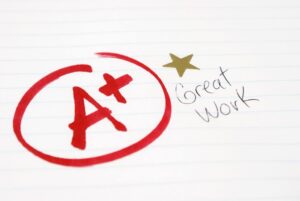Kevin Ruiz is a senior at Cleveland STEM High School and a marketing intern at Floop.
Self Grading
This blog was created with the help of Mark Barnes, a well-known person in the teaching industry and founder of Times 10 Publications. I asked him a few questions regarding self-grading and he gave me some very good responses, so I would like to thank him for that. Now onto the blog.
Self-grading is when a student self assesses an assignment or test and they evaluate how they think they did on the assignment. For self-grading to work, both the students and teachers have to understand what it takes for self-grading to work and benefit both sides. As a student who has been asked to self assess, I always tried to be as honest as I could with myself, and occasionally there had been times where maybe I gave myself a better grade than I deserved. I also noticed other students grading themselves much higher than what they knew they deserved. Soon enough the teacher in our science class who had self-assessing pulled up some data and showed that the overall grades we were handing out to ourselves weren’t matching our test grades, so the system of self-grading in this aspect was not working because, for whatever reason, the teacher and students weren’t on the same page, maybe the teacher didn’t fully communicate the meaning and importance of self-grading. If a student is truly invested in giving themself an honest grade, then they will have this system of self-grading working at its best and it will benefit them the most but what that I believe a teacher has to fully explain and show the students the importance of self-grading because if they don’t, then this system simply won’t work for all.
How to make it work
Self-grading relies on an accurate grade and to receive an accurate grade from the student, a teacher needs to have a well-built self-grading system that will show a student the weaknesses they may have and make them want to improve on that. Me being a student, if I see that I’m completely failing in one subject like math compared to reading and writing which comes easier to me, then I will probably focus more and take more time working on math. A self-grading system that can identify what a student needs to work on and show that students that can improve in that specific area will be able to help the teacher as well because they can now focus on certain things with their students. A teacher and student who know what they need to work on together will not only make the student better but the teacher better, a teacher may be able to plan a whole lesson around what they received from a collection of self-assessment. Self-assessing doesn’t only have to include a student giving themselves a grade A-F, it could also include things that they feel they need help on, how they feel on a project or assignment, and mainly a lot of questions that will help teachers receive feedback on both student and teacher material.
Virtual Self Grading
Self-grading wouldn’t change much through virtual learning, there are many ways to use self-grading through online classes. An App like Floop is a great example of how teachers can connect with students and receive feedback on assignments or even have a student self assess their assignments. In a time like this, it’s important that teachers stay connected with students and also important that students are still able to evaluate their work, when working in what feels like an isolated setting, students may question if a teacher gives them a grade they don’t like but they may feel like it’s just hard to understand everything when it’s not right in front of your face. I know I’ve felt like that and I couldn’t reach out to my teacher and tell them how I felt. We should continue to practice self-grading even in these conditions as it can be very effective and really improve how a student works and views feedback from a teacher, as a student, if I’m able to have a say in my grade I would take that very seriously and try to find where I could improve if that means I’m able to get better as a learner and student. A self-grading in a classroom would like a survey link that is given to the students to fill out since I believe that is the best way during these times, that is just one example of the many! Students have the tools to have a very successful experience with self-grading as long teachers continue emphasizing this and taking the proper steps to have their students using it efficiently.
